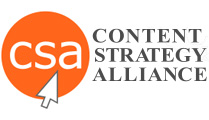Template of the Week – Search Engine Optimization
(This is part of a series of articles highlighting the templates from Content Strategy Alliance Tools & Templates: A Best Practices Handbook we created in 2014. Check back at the end of 2020 for a revised and expanded handbook.)
By Lisa Trager
The best way to rank organically for search is to develop great content! When people search, they are seeking a solution to a question to help them learn, shop, fix, or understand something. Develop a content strategy that addresses how to best inform and answer questions that your target audience is interested in reading, watching, and generally engaging in through the content you build on your site.
A key strategy is to keep content fresh and relevant to your audience. Integrating a blog or adding whitepapers is a good way to stay on top of trends and keep people coming back to your website. Videos are also great vehicles to drive brand awareness – and don’t forget to encourage social sharing as social signals are becoming an influencing factor in SEO. A huge no-no is duplicating content within your website.
Recent google algorithms place more emphasis on site authority. One tactic that can help increase your site’s authority is to include outbound links to government or educational websites, which already have indisputable authority. Even better, is to have a site considered to have high authority link to your site. These can include media or news sites, government, or even sites representing large organizations.
There are mechanics as well as strategies that are considered best practices for SEO. From a build perspective, the 3 most important elements of the page include:
- Page titles that target your audience with key phrases.
- URLs that are clean, reflect hierarchy of information, and can be read by human beings
- Content that is relevant to a specific topic, which is linkable, responsive, and loads quickly
Although most people know the importance of keyword research, the real value can come from finding the “long-tail” words or words that will not be highly competitive in search engine results. Long-tail words are great for inspiring new topics to consider. However, when contemplating the best word for a page title, I’ll often consult Google Trends and go for volume. Once you have determined the best word to use as the subject of your page, be sure to include it in the URL, page title, in the image alt tag, and several times in the text in the body of the page.
Metatags are the language of robots. Be sure to use them and consider the following guidelines:
- Leverage URLs that are short and keyword rich. According to Google, the first 3-5 words in a URL are given the most weight.
- Keep page titles under 55 characters to ensure that they display properly in search results.
- Keep in mind that search engines may choose to display a different title than what you provide in your HTML. Titles in search results may be rewritten to match your brand, the user query, or other considerations.
- Recent updates Google made to their CSS has resulted in variations to how many characters will be displayed in desktop. According to research done by Hobo-web.co.uk, you can use as many characters that fit into a “block element that’s 512px wide and doesn’t exceed 1 line of text.”
- Google enables longer page titles in mobile.
- Use upper and lower text in the meta-title tag versus all caps.
- Use H-tags for all headers and sub-heads
- Never use registered trademark symbols (e.g. ® or ™) in meta tags because they can hurt your page ranking and look strange in search engine results, which lessen click-through rates
When in doubt, I highly recommend the following resources:
- Moz The Beginner’s Guide to SEO
- Search Engine Land Periodic Table of SEO Success Factors
- Google Webmaster Guidelines
- BackLinko Google’s 200 Ranking Factors: The Complete List

Leave a Reply
Want to join the discussion?Feel free to contribute!